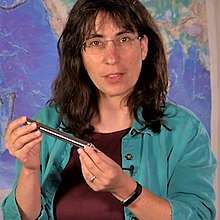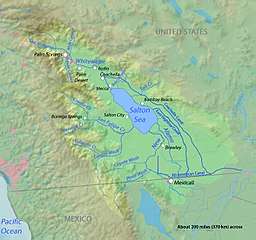Emily Brodsky
Emily E. Brodsky is a Professor of Earth Sciences at the University of California, Santa Cruz. She studies the fundamental physical properties of earthquakes, as well as the seismology of volcanoes and landslides.
Emily E. Brodsky | |
|---|---|
 Brodsky with undersea trench thermometer in 2017 | |
| Alma mater | Harvard University California Institute of Technology |
| Known for | Earthquake physics |
| Awards | James B. Macelwane Medal (2008) |
| Scientific career | |
| Institutions | University of California, Santa Cruz |
Early life and education
Brodsky earned her bachelor's degree Magna cum Laude at Harvard University in 1995.[1] Whilst there, she set up Harvard Undergraduate Television. Brodsky moved to California for her PhD, completing her doctorate in 2001 from California Institute of Technology. She worked on rectified diffusion theory, the mechanism that describes how strain waves pump volatile organic compounds into bubbles.[2][3] Rectified diffusion theory can move dynamic strain from a volcanic tremor or tectonic earthquake to static strain inside a magma chamber.[2] Soon after graduating Brodsky joined the University of California, Santa Cruz. Here she helped several National Science Foundation-MARGINS postdoctoral fellows, including Heather M. Savage and Christie D. Rowe, begin their careers in geophysics.[4]
Research and career

Brodsky has extensively studied the physics of earthquakes.[5][6] She has investigated what causes earthquakes to trigger, as well as their hydrogeology and fault zone structure.[7] The impact of earthquakes on subsequent earthquakes ('triggering') is still not well understood. Brodsky demonstrated that seismic waves can general locally seismic waves.[8] She found that dynamic stress waves from one earthquake can initiate further earthquakes.[9] She has challenged the idea that static stress controls earthquake triggering, and found that aftershocks have similar distributions as main shocks.[9][10] She showed that using the amplitude of previous earthquakes it is possible to predict earthquake triggering at all distances.[11] By studying the Salton Sea geothermal field, Brodsky showed that there was a relationship between human activity and seismic activity.[12] Fault slips can cause nearby rocks to fracture, changing the shape of the surface underneath them and turning the rocks on the floor into powder.
She became interested in the permeability of fractured rocks, demonstrating that seismic waves can unclog fractures.[13] Brodsky identified that the build up of pressure can causes changes in groundwater during earthquakes.[14] After earthquakes, Brodsky drills deep within the fault zone to monitor the temperature.[15] She studied the 2011 Tōhoku earthquake and tsunami, finding a series of temperature pulses that occur due to the flow of fluids through a zone of increased permeability. Immediately after an earthquake, the fault zone can be damaged and have higher permeability, but heals within a few months.[16] Generally, earthquakes are triggered when tectonic stress overcomes friction, and Brodsky became interested in what causes this friction in the first place. Brodsky has shown that the coefficient of friction after the 2011 Tōhoku earthquake and tsunami was considerably lower than expected.[17] Alongside earthquakes, Brodsky studies volcanoes, geysers, landslides and rivers.[18] Occasionally, volcanoes are triggered by distant earthquakes. Brodsky predicted that, alongside growth of bubbles and overturn of magma chambers, volcanoes could be triggered by failure of rocks surrounding a magma chamber.[18]
Brodsky serves on the board of directors for the Southern California Earthquake Center and the IRIS Consortium.[19][20] She has written for The Conversation.[21]
Awards
Her awards and honours include;
- 2005 Seismological Society of America Charles Richter Early Career Award[22]
- 2008 American Geophysical Union James B. Macelwane Medal[9]
- 2009 National Science Foundation Earthscope Distinguished Lecturer[23]
- 2017 International Ocean Discovery Program Ocean Discovery Distinguished Lecturer[24]
References
- "Predict Earthquakes? Prof. Emily Brodsky on progress in the science". Meetup. Retrieved 2019-04-10.
- Brodsky, E. E.; Sturtevant, B.; Kanamori, H. (1998). "Earthquakes, volcanoes, and rectified diffusion". Journal of Geophysical Research: Solid Earth. 103 (B10): 23827–23838. doi:10.1029/98JB02130. ISSN 2156-2202.
- Sturtevant, Bradford; Kanamori, Hiroo; Brodsky, Emily E. (1996). "Seismic triggering by rectified diffusion in geothermal systems". Journal of Geophysical Research: Solid Earth. 101 (B11): 25269–25282. doi:10.1029/96JB02654. ISSN 2156-2202.
- "Dr. Christie D. Rowe". websites.pmc.ucsc.edu. Retrieved 2019-04-11.
- Kanamori, Hiroo; Brodsky, Emily E (2004-07-13). "The physics of earthquakes". Reports on Progress in Physics. 67 (8): 1429–1496. doi:10.1088/0034-4885/67/8/r03. ISSN 0034-4885.
- "People - UC Santa Cruz Seismology Laboratory". websites.pmc.ucsc.edu. Retrieved 2019-04-10.
- "People - UC Santa Cruz Seismology Laboratory". websites.pmc.ucsc.edu. Retrieved 2019-04-10.
- Brodsky, Emily E.; Karakostas, Vassilis; Kanamori, Hiroo (2000-09-01). "A new observation of dynamically triggered regional seismicity: Earthquakes in Greece following the August 1999 Izmit, Turkey earthquake". Geophysical Research Letters. 27 (17): 2741–2744. doi:10.1029/2000gl011534. ISSN 0094-8276.
- "Emily E. Brodsky". Honors Program. Retrieved 2019-04-10.
- Brodsky, Emily E.; Felzer, Karen R. (2006-06-08). "Decay of aftershock density with distance indicates triggering by dynamic stress". 441. Cite journal requires
|journal=(help) - van der Elst, Nicholas J.; Brodsky, Emily E. (2010-07-29). "Connecting near-field and far-field earthquake triggering to dynamic strain". Journal of Geophysical Research. 115 (B7). doi:10.1029/2009jb006681. ISSN 0148-0227.
- Lajoie, Lia J.; Brodsky, Emily E. (2013-08-02). "Anthropogenic Seismicity Rates and Operational Parameters at the Salton Sea Geothermal Field". Science. 341 (6145): 543–546. doi:10.1126/science.1239213. ISSN 0036-8075. PMID 23845943.
- Elkhoury, Jean E.; Brodsky, Emily E.; Agnew, Duncan C. (2006). "Seismic waves increase permeability". Nature. 441 (7097): 1135–1138. doi:10.1038/nature04798. ISSN 0028-0836. PMID 16810253.
- Brodsky, Emily E.; Roeloffs, Evelyn; Woodcock, Douglas; Gall, Ivan; Manga, Michael (2003). "A mechanism for sustained groundwater pressure changes induced by distant earthquakes". Journal of Geophysical Research: Solid Earth. 108 (B8). doi:10.1029/2002JB002321. ISSN 2156-2202.
- "Voices From the Future: Conversation With Emily E. Brodsky | NSF - National Science Foundation". www.nsf.gov. Retrieved 2019-04-10.
- Huang, Yao; Sun, Zhi-Ming; Yang, Guang; Zhang, Wei; Pei, Jun-Ling; Si, Jia-Liang; Mori, James J.; Wang, Huan; Kano, Yasuyuki (2013-06-28). "Continuous Permeability Measurements Record Healing Inside the Wenchuan Earthquake Fault Zone". Science. 340 (6140): 1555–1559. doi:10.1126/science.1237237. ISSN 0036-8075. PMID 23812711.
- Expedition 343, 343t; Toczko, S.; Eguchi, N.; Lin, W.; Harris, R. N.; Ishikawa, T.; Chester, F.; Mori, J.; Kano, Y. (2013-12-06). "Low Coseismic Friction on the Tohoku-Oki Fault Determined from Temperature Measurements". Science. 342 (6163): 1214–1217. doi:10.1126/science.1243641. ISSN 0036-8075. PMID 24311684.
- Manga, Michael; Brodsky, Emily (2006). "SEISMIC TRIGGERING OF ERUPTIONS IN THE FAR FIELD: Volcanoes and Geysers". Annual Review of Earth and Planetary Sciences. 34 (1): 263–291. doi:10.1146/annurev.earth.34.031405.125125.
- "What We Can and Cannot Predict about Earthquakes". alumni.ucsc.edu. Retrieved 2019-04-10.
- "brodsky | Southern California Earthquake Center". www.scec.org. Retrieved 2019-04-10.
- "Emily Brodsky". The Conversation. Retrieved 2019-04-10.
- "Charles F. Richter Early Career Award | Seismological Society of America - Part 3". www.seismosoc.org. Retrieved 2019-04-10.
- "Voices From the Future: Emily E. Brodsky - Earthquakes Triggered By Seismic Waves | NSF - National Science Foundation". www.nsf.gov. Retrieved 2019-04-10.
- "Past Distinguished Lecturers". U.S. Science Support Program. Retrieved 2019-04-10.